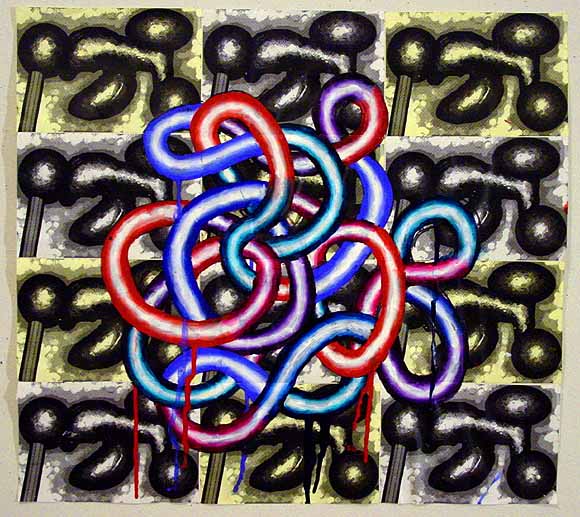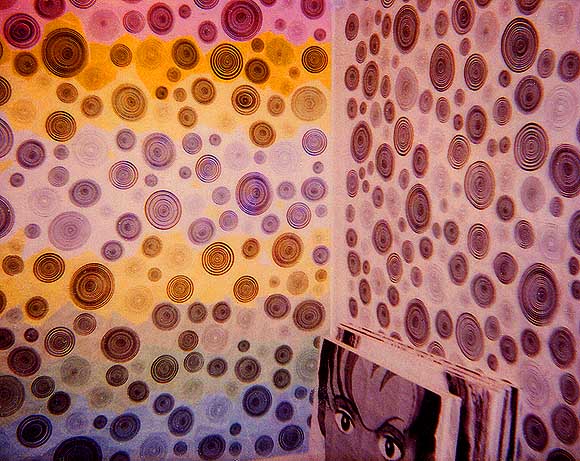View current page
...more recent posts
Great post from collision detection, re-re-blogged from Eyebeam:
Apparently Glad has scored a bit hit with its new ForceFlex garbage bags -- which can stretch to seemingly impossible dimensions, and thus contain the ever-greater volumes of nonrecyclable carcinogens the average American family craps out every day. ("Hey honey, Johnny doesn't like his Jungle Gym anymore!" "No problem, sweetie -- we'll just shove it inside a single ForceFlex garbage bag and send it off to the dump so Johnny's grandchildren can drink the entire goddamn thing 80 years from now when it leaches into the water table.")
Regarding the '90s pieces I just posted, Paul asks if x-eleven, the old school Dallas techno outfit that recently put its entire catalog up on the Net, got me inspired to go through my older work. The answer is not directly, I usually put up older things when I stumble across them looking for something else and they jibe with whatever I'm thinking about now, or possibly because they have nothing to do with that. I consider any painted pieces to be hopelessly retrograde and superseded and if I post them it's because I'm, well, let's just say proud of them for the time I made them.
A show recently opened in Brooklyn called "Decipher: Hand Painted Digital" that my work was considered for and...I don't know if rejected is the right word because the curator said all the artists had to live or have studios in Brooklyn. Oy. He added that subheading "hand painted digital" after the time of our discussions and I gotta say it's a bit unfair to the artists in the show who abandoned the security blanket of paint to paint in a new medium. Many of the included painters do use the computer in one or more steps of their work--to generate imagery, photo-process, possibly check out color combinations, I don't know--but there's nothing particularly "cyber" on the face of it. At its worst, "hand painted digital" suggests a painter trying to stay current or "hep" by painting digital, or digital-looking imagery, in his or her old style.
Back to x-eleven: I consider it to be J. S. Bach, not a period piece, though some of the technology and much of the motivation (make cool music for a rave, expand minds, get out of Arlington, TX) no longer exists per se. I'm just amazed by how complex and intense it is, and I suppose I mentally subtract out anything cheesy or dated. I do that with a lot of prog rock as well.

I think was done in '95--it's a transition between my painted and computer pieces.
A friend says he can't believe I paid money to see Assault on Precinct 13 (discussed in an earlier post). I told him what I really wanted to do was talk about the John Carpenter version, from 1976. I had actually written a "preReview" of the Ethan Hawke remake, but felt it was lame not to actually see it if I was going to bitch so much. So I sucked it up and paid. Anyway, my compare-and-contrast has been rewritten somewhat, beefing up the Carpenter tribute.

Another view of my 54th St. studio, circa 1999 (scan of polaroid), from the vault.
From Leonard Maltin's movie guide, 2010 edition:
Assault on Precinct 13: Before Sunrise (2005) ** D: Jean-Francois Richet. Ethan Hawke, Laurence Fishburne, Maria Bello, Ja Rule. Overwritten remake pads out John Carpenter's lean, mean low budget 1976 thriller Assault on Precinct 13 with Hollywood psychobabble and a host of added characters meant to broaden its appeal. Permanently perplexed slacker Ethan Hawke bores and overacts in the Austin Stoker role as a cop who must defend an abandoned police precinct building (and its accidental inhabitants) from a military-style assault by mysterious foes. Still playing Morpheus from the Matrix movies, Laurence Fishburne occasionally amuses as a prisoner temporarily housed in the building who joins in its defense.The original movie, a pulp masterpiece of the type that the Hollywood cool kids admire but always ruin by trying to recreate, flopped on release, reportedly running for 24 hours in a seedy Times Square theatre, but gradually acquiring a rep as Carpenter's star continued to rise with Halloween, The Thing, and so forth. A George Romero-style zombie film with a street gang as the zombies, the first Assault introduced one trapping of the urban crime genre that was years ahead of the curve: too broke to hire a composer, Carpenter invented the cool synthesizer-and-rhythm box score, of the type that later dominated the '80s--a minimal funk machine with a bass line we would now call "classic electro." (Carpenter says he was influenced by Led Zep's "Immigrant Song," which shorn of its viking narrative is proto-techno in its hypnotic simplicity). The Assault music is so good, still, that the DVD gives you an option to hear it with dialogue and sound effects muted.
Partly due to that hip-but-sinister score, partly due to Carpenter's narrative economy and budget-driven sense of visual priorities, and partly due to the '70s zeigeist of "society in freefall," the first movie gives you a sense of "being pulled towards some inevitable doom," as one fan put it. Slate critic David Edelstein, who generally sneers at Carpenter and still twits him 30 years later for the shocking child murder that begins the first Assault, praises the film's atmosphere of "free floating malevolence." Although Carpenter claims no sociological intent for the movie, one senses throughout that it is urban anomie and neglect as much as a relentless gang vendetta that besieges the characters inside a soon-to-be-closing police station, with no cavalry in sight.
The remake does away with the difficult, unforgettable opening murder scene and shifts the villainy from a street gang to "crooked cops," which is a cliche, but it does give the film its only subversive juice. Over the course of its too-long running time, the film's added assortment of Offbeat Ghetto Characters--or so the scriptwriters seem to imagine them--waste a lot of gendarmes in scary high tech riot gear and the audience is encouraged to root for that. In a time when our police forces seem bent on remaking themselves into the military wing of the Republican Party, and in anticipation of their eventual merger with private security contractors currently guarding the elite (or just if you hate armed authority figures), the counter-assault has a certain cathartic appeal, outside the film's lame blaxploitation-with-Ethan-Hawke context.
UPDATE: J. Hoberman, a fan of the original movie, likes the remake.
Chris Ashley, Untitled (Transit, Windows, Ribbons), 2005, HTML, 500 x 460 pixels
Most Condescending Art Critic Comment of 2005 (So Far)
Peter Schjeldahl, The New Yorker:
A leading exegete of theory on the scene, Craig Owens, hatched the keenest critique of East Village art, in one word: "Puerilism." (Why the slur's victims didn't promptly embrace it, on the model of "Fauvism," I don't know; maybe they lacked ready access to a dictionary.)More.
